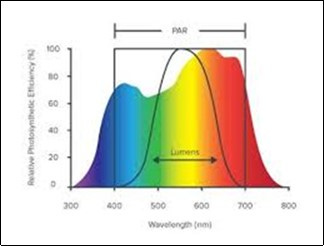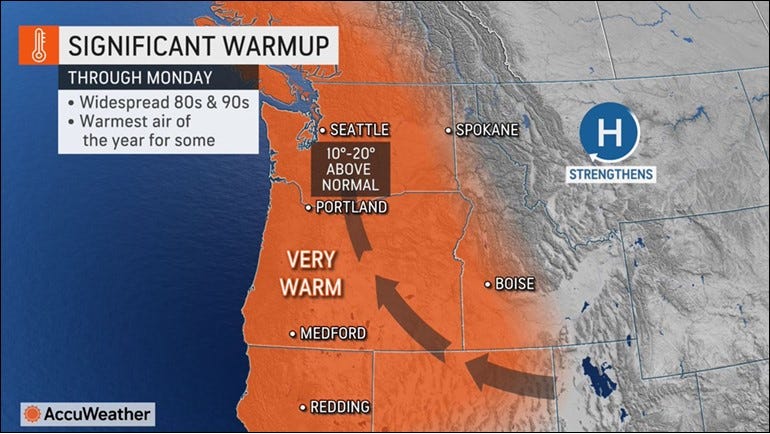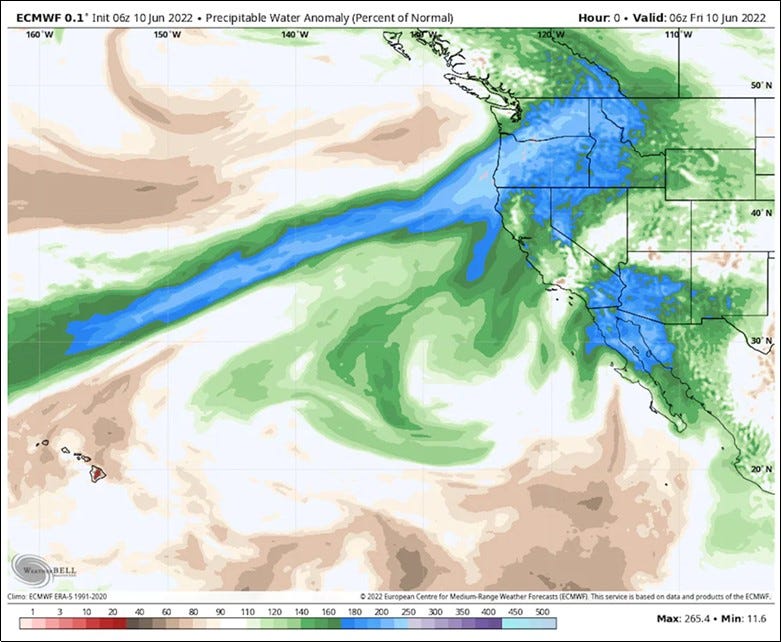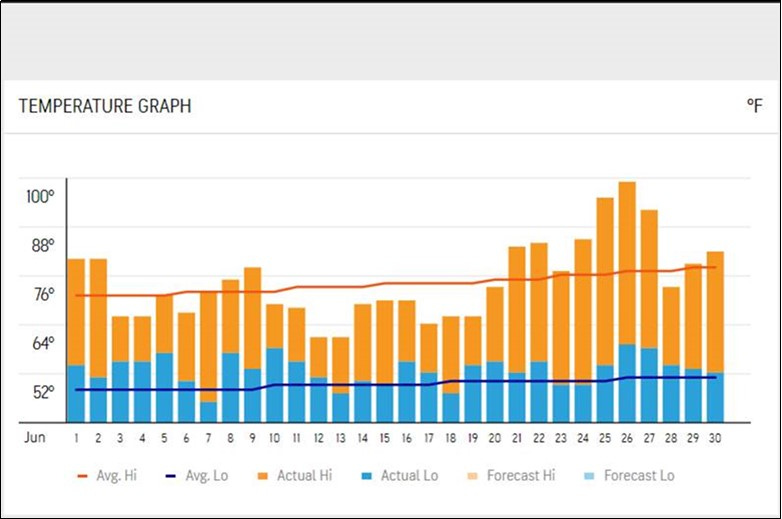Amalie Robert Estate Climate Update: June 2022
Hello and Welcome,
This is the Vintage 2022 June Climate Update.
Since the turn of the century, every vintage that we have grown Pinot Noir in the Willamette Valley has been different. And yet, it’s always the same. Hurry up and then wait. The vines have about a 6-month window from waking up in spring with bud break, to harvest and returning to winter dormancy.
Spring brings rain, hail, frost and if you are lucky a few nice days to get the vineyard floor ready to go. Summer brings the heat and the vines take up all of that available soil moisture. They grow so fast you can almost see them grow. Ernie says he can hear them, “Hey you! Raise the catch wires and tuck my shoots!”
Then we wait for the magic of aroma and flavor development, while we set our harvest dates with a watchful eye on sugar accumulation. It’s a lot of fits and starts, non-linear and difficult to forecast. We know what’s going to happen, we just don’t know when. We used to count on 105 days from flowers to the Great Cluster Pluck, but as with most things nowadays, it is all relative.
The Big Picture
Whatever else June brings to the growing season, it is time to raise the trellis catch wires. It’s all part of the plan to maximize the solar array known as the canopy and set the stage for hedging off the shoot tips. The leaves are the energy sector of the vine. The rest of the vine’s economy depends on the leaves conducting their photosynthesis business unhindered.
Up to a point. And that point is about 90 inches above the ground. If it is looking like a hot vintage, Ernie may set the hedger a little lower to take more of the leaves from the upper story of the canopy. Their contribution will most likely manifest itself as higher sugar concentration in the wine berries, thus forcing an early harvest before aroma and flavor have developed.
But if we are late in flowering, and its looking like we may run out of growing season with a cool and rainy fall, Ernie will leave that upper set of leaves. We just may need them to achieve complete physiological wine berry ripeness. What does it mean when Ernie keeps writing the year as 2011?
Winemaking: The Continuation of Terroir by Other Means.® by Dena & Ernie is the repository of our farming history at Amalie Robert Estate. A FLOG communication (Farming bLOG).
We have over 200 posts going back some 20 years. It’s all out there. More than you would ever want to know about farming wine. Check us out on Substack.
If you want to see what we see, follow along with vintage 2022 on our Instagram account @AmalieRobert.
Planning to enjoy traveling again and exploring the Willamette Valley? Amalie Robert Estate is open year round by appointment for vineyard tours and tastings. Request a tasting appointment with your preferred day and time.
The Main Story
There is a reason jumbo jets don’t land at municipal airports – they would run out of runway to safely land the plane. Some exceptions are made in Ireland (Ernie lives to tell the tale). And that is the main story for Vintage 2022.

As you can see from the graph above, our flowering date of June 27 (Julian calendar date 178), is about 2 weeks later than the historical average at Amalie Robert Estate. While the flowering date can vacillate wildly, the 105 days needed to develop aroma and flavor does not. Arithmetic, being a relatively straightforward mathematical concept, is absolute. We see a harvest window opening on October 10th.
Now we get out the crystal ball and see that it rains in Oregon in October. Sometimes Mother Nature gets ahead of herself, and it rains in September. It always rains in November. We are planning to conduct harvest operations beginning the second week of October. If you organize parades, you understand the implication.
So, will the wine berries be ripe on October 10th? On the one hand, yes they will have had enough time on the vine to accumulate fermentable sugar to make wine. On the other hand, if the summer is cool, overcast, cloudy and the rains come early effectively shortening the growing season, the wine berries may lack fully developed aroma and flavor. This is why we only use one hand when making harvest decisions.
What Does This Mean and Why Should I Care
Harvest is a physical implementation of a winemakers mental construct. Winemakers (should) have a stylistic interpretation of the variety they wish to produce. For example, we prefer the elegance, spice and tannins of whole cluster fermentation. That is our interpretation of Pinot Noir.
Harvest too soon, or too late, and you miss the stylistic aroma, flavor and texture you are striving for. Leaves, and removal thereof, have a dramatic impact on a vine’s ripening ability as well as shaping the aroma, flavor and tannins in the finished wine. But the leaves can only take in the sunshine that is available.
Vintage adds the variable. Hot or cold makes little difference to the vine. Vines respond according to their stimulus - primarily heat, available soil moisture and Photosynthetic Active Radiation. Photosynthetically Active Radiation (PAR) is the amount of light available for photosynthesis, which is light in the 400 to 700 nanometer wavelength range. PAR changes seasonally and varies depending on the latitude and time of day.
Levels are greatest during the summer at mid-day. Factors that reduce the amount of PAR available to plants include anything that reduces sunlight, such as cloud cover, shading by trees, and buildings. Air pollution also affects PAR by filtering out the amount of sunlight that can reach plants. While you don’t hear much about it, global dimming is a real thing.
At Amalie Robert Estate, the ultimate decision of when to pluck these wine berries from the vine is made by aroma and flavor. Vintage variation aside, the path to aroma and flavor development remains consistent. In Pinot Noir, aroma and flavor development starts with ruby red grapefruit character, followed by bright red cherry, moving into Montmorency cherry then transition to plum and finally raisin.
In a cool vintage, we may not get past bright red cherry aroma and flavor at low sugar concentrations by the time we run out of growing season. By definition, we run out of growing season when the rains prevent harvest operations, or the fruit rots. That’s how you know when you are done harvesting.
Hence the reference to 2010 and 2011. These were cool vintages that provided lighter bodied wines with elegant aroma, flavor and texture at lower alcohol. However, the harvest window remained open well into November. So even though we had a late bloom, we had plenty of growing season (105+ days) for aroma and flavor development.
Alternatively, in a hot vintage we may find ourselves at ruby red grapefruit aroma and flavor with excessive sugar concentrations well before we reach 105 days. While the wine berries are sugar ripe, they are not aroma and flavor ripe.
High sugar concentrations from lack of available soil moisture and desiccating heat and wind will force an early harvest. Otherwise, the yeast will die before they can ferment all of the sugar. No matter what you may hear or see, sweet Pinot Noir is nobody’s first interpretation of this variety. Especially if it is aged in bourbon barrels.
Right. At this point of the growing season, we can begin to mentally prepare for a full month long October harvest window. We will continue to monitor the summer heat units and rainfall. Once we reach about 90 to 100 days past flowering, it is time to kit out the lab to test sugar and acid concentrations, then wash up the harvest totes and buckets. Then the fun begins - a little game of chicken with Mother Nature.
The Numbers
June is the Gemini month, and we have had that (Jun-uary) experience. “Expressive and quick-witted, Gemini represents two different personalities in one and you will never be sure which one you will face.” The first half of the month was wind driven rain and a tad bit of hail. The second half of the month gave us an abrupt run up to 96 sweltering degrees which forced bloom. Still, we were shy of the June 2021 record of 118 degrees, so we have that going for us - which is nice.
For the month of June, we logged 298 Degree Days. That brings the growing season to-date total to 500.7 Degree Days. We would like to see about 2,100 Degree Days by the middle of October. It is an election year, so there could be some hot air coming into the Pacific Northwest, but will it arrive in time? The high temperature for the month of June was 96.0 enduring from 5:00 pm to 6:00 pm on June 26th. This triggered the vines to begin flowering. The low temperature for the month was 41.9 degrees recorded on June 13th at 4:12 am. This triggered Ernie to build a fire in the kitchen cookstove.
Rainfall and hailfall for the month of June stands at 2.87 inches, with all of that falling in the first 3 weeks of the month. As is typical in Oregon, we do not expect any meaningful precipitation until maybe September, probably October and surely in November. And that will be just about the right time to cluster pluck some cool climate Syrah, which has yet to flower… Total rainfall for the growing season April through June now stands at 13.05 inches.
And if you have never heard of an Atmospheric river, this is what it looks like. This early June phenomenon was responsible for several days of measurable precipitation, some of them quite heavy. It is never good, but it is better to have this weather event now instead of harvest. Of course there was 2013, when Typhoon Pabuk came to harvest… There is never a dull moment in a Willamette Valley Cluster Pluck.
For those more graphically inclined, this image from AccuWeather sums up the month of June very succinctly.
Diesel is now running $6.22 per gallon. A gallon of diesel weighs in at just under 7 pounds. In Canada a gallon weighs more, but that is because they measure a gallon differently. It’s more bigger, eh? Here in Oregon, diesel works out to be about 89 cents a pound. Zucchini is about $1.49 a pound. It’s important to bear in mind that sometimes, a Zucchini is just a Zucchini.
Kindest Regards,
Dena & Ernie











